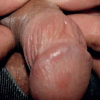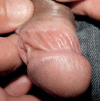A prospective, open, comparative study of 5% potassium hydroxide solution versus cryotherapy in the treatment of genital warts in men
- PMID: 24770498
- PMCID: PMC4008052
- DOI: 10.1590/abd1806-4841.20141702
A prospective, open, comparative study of 5% potassium hydroxide solution versus cryotherapy in the treatment of genital warts in men
Abstract
Background: Genital warts are caused by human papillomavirus infection and represent one of the most common sexually transmitted diseases. Many infections are transient but the virus may recur, persist, or become latent. To date, there is no effective antiviral treatment to eliminate HPV infection and most therapies are aimed at the destruction of visible lesions. Potassium hydroxide is a strong alkali that has been shown to be safe and effective for the treatment of genital warts and molluscum contagiosum. Cryotherapy is considered one of the most established treatments for genital warts. No comparative trials have been reported to date on the use of potassium hydroxide for genital warts.
Objective: A prospective, open-label, randomized clinical trial was conducted to compare topical potassium hydroxide versus cryotherapy in the treatment of genital warts affecting immunocompetent, sexually active men.
Methods: Over a period of 10 months, 48 patients were enrolled. They were randomly divided into two groups and selected on an alternative basis for either potassium hydroxide therapy or cryotherapy. While response to therapy did not differ substantially between both treatment modalities, side effects such as local pain and post-treatment hypopigmentation were considerably more prevalent in the groups treated using cryotherapy.
Result: In our study, potassium hydroxide therapy proved to be at least as effective as cryotherapy and offered the benefit of a better safety profile.
Conclusion: Topical 5% potassium hydroxide presents an effective, safe, and low-cost treatment modality for genital warts in men and should be included in the spectrum of therapies for genital warts.
Conflict of interest statement
Conflict of Interest: None.
Figures
Similar articles
-
Comparison of topical potassium hydroxide 5% solution with cryotherapy in the treatment of patients with genital warts: A randomized controlled clinical trial.Int J STD AIDS. 2025 Mar;36(3):205-211. doi: 10.1177/09564624241300776. Epub 2024 Nov 26. Int J STD AIDS. 2025. PMID: 39600100 Clinical Trial.
-
Comparison Of Efficacy Of 10% Potassium Hydroxide Solution Versus Cryotherapy In Treatment Of Molluscum Contagiosum.J Ayub Med Coll Abbottabad. 2016 Apr-Jun;28(2):382-385. J Ayub Med Coll Abbottabad. 2016. PMID: 28718569 Clinical Trial.
-
Comparison of 10% potassium hydroxide solution versus cryotherapy in the treatment of molluscum contagiosum: an open randomized clinical trial.J Dermatolog Treat. 2014 Jun;25(3):249-50. doi: 10.3109/09546634.2013.832135. Epub 2013 Aug 27. J Dermatolog Treat. 2014. PMID: 23924070 Clinical Trial.
-
Therapy for genital human papillomavirus-related disease.J Clin Virol. 2005 Mar;32 Suppl 1:S82-90. doi: 10.1016/j.jcv.2004.10.020. J Clin Virol. 2005. PMID: 15753016 Review.
-
Traditional therapies for the treatment of condylomata acuminata (genital warts).Australas J Dermatol. 1998 Nov;39 Suppl 1:S2-4. Australas J Dermatol. 1998. PMID: 9842092 Review.
Cited by
-
A Comparative Study of Liquid Nitrogen Cryotherapy as Monotherapy versus in Combination with Podophyllin in the Treatment of Condyloma Acuminata.J Clin Diagn Res. 2017 Mar;11(3):WC01-WC05. doi: 10.7860/JCDR/2017/23797.9339. Epub 2017 Mar 1. J Clin Diagn Res. 2017. PMID: 28511487 Free PMC article.
-
Comparative Evaluation of Topical 10% Potassium Hydroxide and 30% Trichloroacetic Acid in the Treatment of Plane Warts.Indian J Dermatol. 2016 Nov-Dec;61(6):634-639. doi: 10.4103/0019-5154.193670. Indian J Dermatol. 2016. PMID: 27904181 Free PMC article.
-
Local Management of Anogenital Warts in Non-Immunocompromised Adults: A Network Meta-Analysis of Randomized Controlled Trials.Dermatol Ther (Heidelb). 2020 Apr;10(2):249-262. doi: 10.1007/s13555-020-00357-z. Epub 2020 Feb 6. Dermatol Ther (Heidelb). 2020. PMID: 32030564 Free PMC article.
-
Local Management of Anogenital Warts in Non-immunocompromised Adults: A Systematic Review and Meta-analyses of Randomized Controlled Trials.Dermatol Ther (Heidelb). 2019 Dec;9(4):761-774. doi: 10.1007/s13555-019-00328-z. Epub 2019 Oct 13. Dermatol Ther (Heidelb). 2019. PMID: 31606873 Free PMC article.
-
A Comparative Study of Potassium Hydroxide versus CO2 Laser Vaporization in The Treatment of Female Genital Warts: A Controlled Clinical Trial.Int J Community Based Nurs Midwifery. 2016 Jul;4(3):274-82. Int J Community Based Nurs Midwifery. 2016. PMID: 27382594 Free PMC article.
References
-
- Cates W Jr, American Social Health Association Panel Estimates of the incidence and prevalence of sexually transmitted diseases in the United States. Sex Transm Dis. 1999;26:S2–S7. - PubMed
-
- Blackwell M. Human papillomavirus infection. Am J Transplant. 2004;4:95–100. - PubMed
-
- Koutsky L. Epidemiology of genital human papillomavirus infection. Am J Med. 1997;102:3–8. - PubMed
-
- Hebner CM, Laimins LA. Human papillomaviruses: basic mechanisms of pathogenesis and oncogenicity. Rev Med Virol. 2006;16:83–97. - PubMed
Publication types
MeSH terms
Substances
LinkOut - more resources
Full Text Sources
Other Literature Sources
Medical






